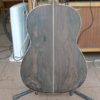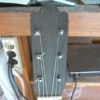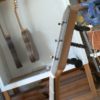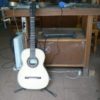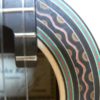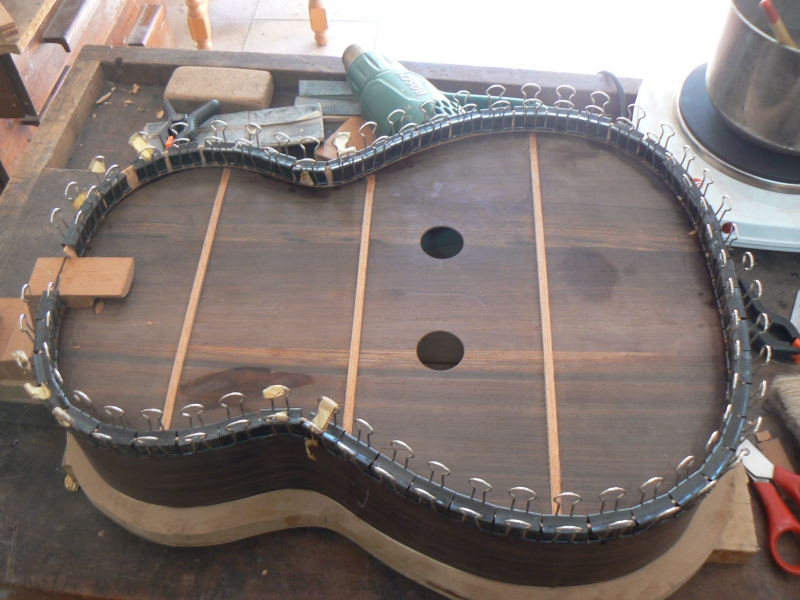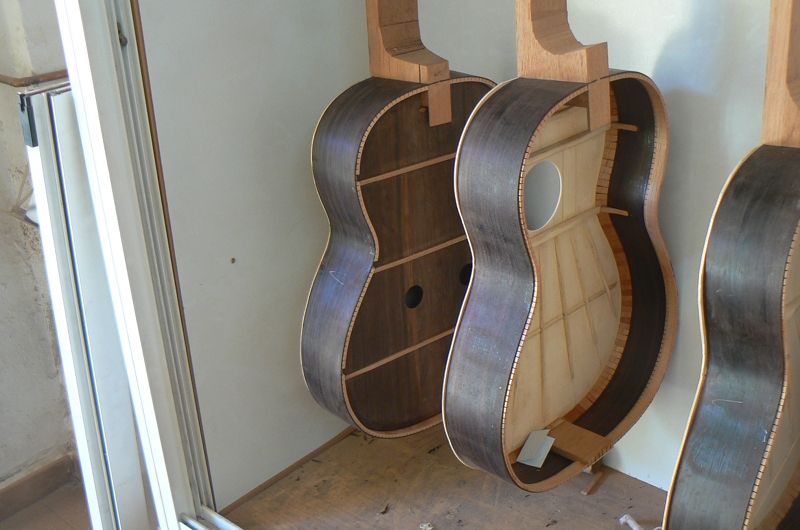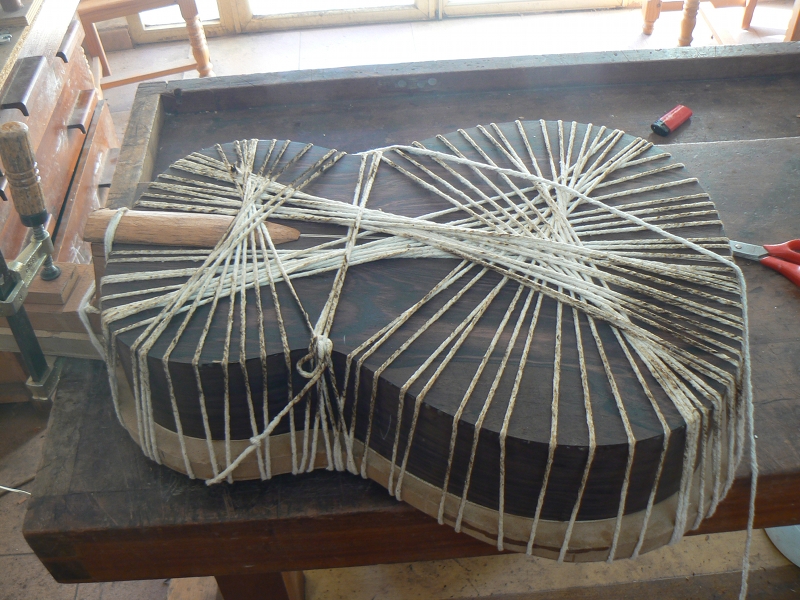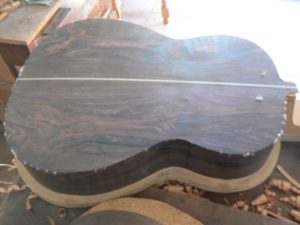This is some information from my examination of the 1900 Vicente Arias. The photos of this guitar can be found here and here. Other articles have details of the building of the first replica. The guitar has a label which tells us that Vicente Arias made it in 1900 shortly after moving to Madrid. It is a relatively simple guitar with good quality wood and excellent craftsmanship but without the obsession with perfection that seems so desirable these days. There is a double back probably 1 to 1.5mm thick with very light bars across it. According to those who have studied other guitars of his he did this to get the sound of a very shallow instrument while giving the physical sensation of playing a full-sized instrument. This explanation doesn’t fit with the two sound-port sized holes in the inside back just below the bridge. Since the outer back has been taken off it is very possible that these holes were made by someone else. It should be noted that the back was taken off and replaced by an amateur or someone with no regard for the original work. The back curve was ruined and no attempt was made to replace the filleting which was destroyed in the cutting. The headstock has also suffered some modification as can be seen in the photos and I think the original holes were plugged and redrilled at some point. The added pieces of cedar on the head might make one think that this head once had tuning machines but I can find no evidence of that. The top is extremely flexible, more so than anything I have ever seen. However, the deformation in front of and behind the bridge is within acceptable limits (the curve in front remains positive) and there are no cracks on the top except for the typical ones along the fretboard. There are three cracks on the outside back, one under the central reinforcement and the other two very likely cleated (perhaps the reason for the back removal?) as they show no movement when stressed. There are some marks of slight burning on the underside of the top perhaps where the top was reheated after glueing the bridge on. The peones are glued with no spaces in between them.
The following are some measurements in mm:
Depth: endblock 93
neck 92
upperbout 91
waist 82
lower bout 92
These would originally have been different but hard to tell by how much after the back removal.
bridge 25 wide and 28.5 with the lip
tie block is 8mm high off the soundboard and the front of the bridge is 6 high
wings are 3 high
soundhole diameter is 86
rosette width is 24.5
three bars on the top
the closest one to the neck is 3 high X6
next one is 15.5 X 6
last one “below the soundhole” is 14 X 6
not scallopped
the bars on the double back are 4 X 5.5
There are 7 fans 3 X 4.5 at the highest point, seemingly planed straight while sitting in the solera so are not uniform height.
they have a rounded profile. The projection of these fans meet very approximately at the 10th fret. I prefer to measure the separation of the fans at the third top bar and then again at the back edge of the bridge. the first measurement is 30mm and the second is 45mm. These round figures indicate that he used these measurements too as opposed to using a converging . Please note on the pictures of the illuminated top the short finger braces, they are shaped just like the fans.
The space between the top and the inside back as measured at the “lower” edge of the soundhole is 79.
the length is 479, upper bout is 264, waist 228 and lower bout 365.
I finally got my hands on a Hacklinger gauge at the same time as I had the Arias in the workshop. I checked it against my caliper on a few pieces of wood and found it was reading 1.6 for 1.7 so I would add 0.1 to the following measurements. At first blush it seems that Mr. Arias settled on 1.6 mm as an appropriate thickness for top, back, double back and sides. The sides in places go down to 1.4 but then anyone who has ever worked with Brazillian can understand that. The back is very close to the double back so I was unable to get the Hacklinger to measure anything but the stretch between the second and third bars on the back and only that thanks to the “soundholes” in the double back. The back showed 1.6 and 1.5 in the central area and 1.3 out towards the sides with lots of variation in the thickness which makes it hard to say with any certainty that this was his intention. Who knows what was done to this back when it was removed. The top shows one very thin area (1.2) where a tap plate was present and you can even feel a depression in that area, I think it is obvious that someone ripped it off, damaged the top and sanded it down and then someone covered it up with another tap plate. There is also a thick area behind the bridge thickest(2.0) near the end block behind the A string. This area thins out gradually in all directions to the 1.6 thickness of the top within a distance of 4 or 5 centimetres. I have no explanation for this although it does make for a thicker are in general behind the bridge. One might think that the rest of the top was sanded down later in the guitar’s life and this part left thick but there are no signs of that, no sharp rising or increased thickness around the bridge and fretboard. The rest of the top shows 1.4 to 1.6 very consistently, a bit heavier on the 1.6 readings (and even two 1.7 readings) between bridge and soundhole. As you approach the edges of the guitar there is no decrease in thickness, actually in the lower bout there is even a tendency of maximum readings around the edges whereas as you move inwards you start to get about 0.1mm less. The top is extremely flexible and I get a resonance at just below F#. I couldn’t get a very accurate measurement of the thickness of the double back but by making a saw cut in a small block of wood that just allowed the “soundport” edge to enter convinced me that thickness is 1.6 as well. The holes in the double back are symmetrical and 32 mm in diameter with a separation of their centres of 96mm. The double back has these tiny braces and then seems to have a second set on the “bottom” side as well, I can only just touch one with a finger. The back brace (at least number 2) is about 15mm closer to the soundhole than the one we see on the double back. The braces on the double back are scalloped but I think the ones on the back are not because I couldn’t get the magnet from the Hacklinger to pass through anywhere. As I think I mentioned before, whoever took the back off destroyed the back curve so assuming that the double back curve is still there then the distance between the two backs was originally greater than it is now (10.5 mm at the holes) At one point I got a vibration by tapping on the back and was very worried about a crack until I realized that the bars of one of the backs is almost touching the other one and vibrated sometimes. I can with very little pressure make them touch. That gives us a pretty good idea how high the back bars are. One of the things I try to do when I study an important instrument is get an idea of what the original archings were. Usually an arch will flatten out under tension after 100 years but the edges of the top (or back) will still have their original angle upwards with respect to the plane of the top. If you place a straight edge along the tangent at the edge you can read the distance the straight edge projects above the opposite edge. This allows us to reproduce a curve for the solera which should allow for the same reading on the finished copy. The idea is that the arch will be the same as the original was in its beginings. I placed my straight edge at the end block just off-centre so as to be able to take a reading at the top edge-23mm. Then at the fretboard and read at the endblock-7mm. Transverse readings just in front of the bridge-13.5mm and on the brace below the soundhole-6mm and mid soundhole-7.5mm. The back had no angles so I have to assume that the edges of the sides and linings were altered when the back was glued on again. Of course it is possible that the original back had no arching at the edges but I sincerely doubt it.

